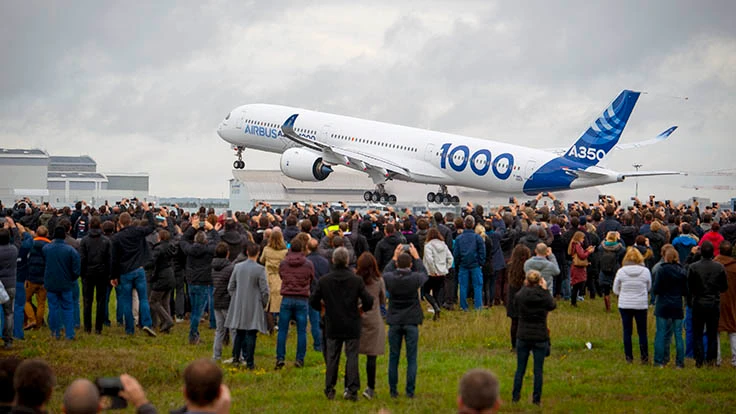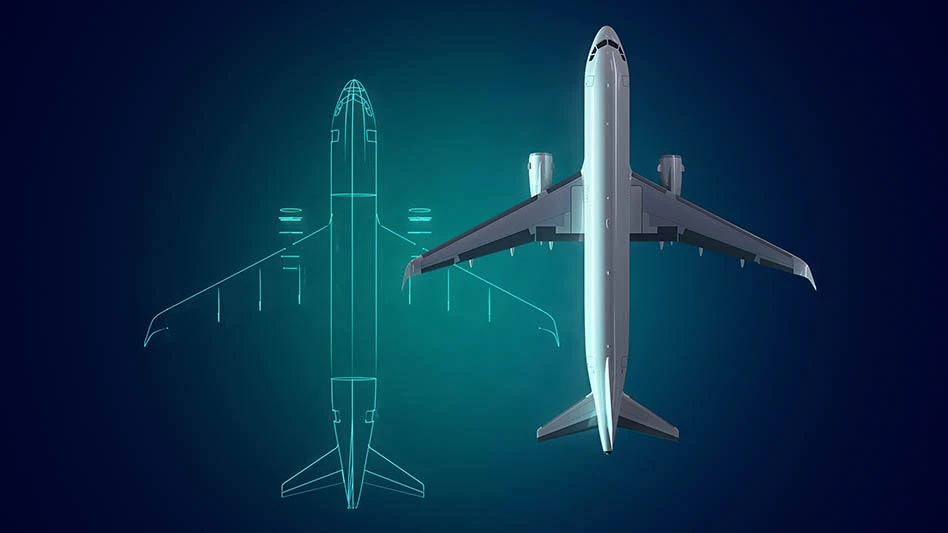
Toulouse, France – The first of three Airbus A350-1000 development aircraft to fly – MSN059 – landed at Toulouse-Blagnac Airport France on Nov. 24, 2016, after successfully completing its first flight of 4 hours and 18 minutes.
The crew in the cockpit on board this flight comprised: Hugues van der Stichel, Experimental Test Pilot; Frank Chapman, Experimental Test Pilot and Gérard Maisonneuve, Test-Flight Engineer. Monitoring the test parameters at the Flight-Test-Instrumentation (FTI) station behind the cockpit were: Patrick du Ché, Head of Flight & Integration Tests; Emanuele Costanzo, Head of A350 Development Flight Tests; and Stéphane Vaux, Flight-Test Engineer.
Powered by Rolls-Royce’s new Trent XWB-97 engines, the aircraft traversed south-western France, during which the crew explored the aircraft’s handling and flight envelope. The aircraft was accompanied by a chase plane to observe and film the various maneuvers. Its progress was monitored by experts on the ground in real-time via a direct telemetry link.
Airbus President and CEO Fabrice Brégier said: “We have seen today the world’s most modern and efficient passenger aircraft – the A350-1000 – in action for the very first time, adding soon to the successful A350 family. My congratulations and thanks go to all the teams who have contributed to make today’s flight happen.”
Many customers witnessed the flight from Airbus headquarters in Toulouse.
Benefiting from the experience of the original A350-900 test campaign (accomplished in 2014), the A350-1000’s development program will be shorter – less than one year for the three aircraft. MSN059’s duties for performance testing will include exploration of the flight envelope, handling qualities, loads and braking. The second aircraft to fly, MSN071, will also be tasked with performance evaluation, which will encompass braking, powerplant, systems, and autopilot. The third and final aircraft to fly – MSN065 – will be equipped with a cabin and will evaluate the cabin and air systems. MSN065 will also perform the early long flights and route-proving. The overall campaign will culminate in the type’s certification followed by its entry into airline service in the second half of 2017 with first operator Qatar Airways – the largest A350-1000 customer to date with 37 on order.
Having a longer fuselage to accommodate 40 more passengers than the A350-900, the A350-1000 also features a modified wing trailing-edge, new six-wheel main landing gear, and more powerful Rolls-Royce Trent XWB-97 engines. The A350-1000 embodies all of the fuel efficiency and Airspace cabin comfort of the original A350-900 – but with extra size for long-haul routes. To date, 11 customers from five continents have placed orders for a total of 195 A350-1000s.
Source: Airbus
The crew in the cockpit on board this flight comprised: Hugues van der Stichel, Experimental Test Pilot; Frank Chapman, Experimental Test Pilot and Gérard Maisonneuve, Test-Flight Engineer. Monitoring the test parameters at the Flight-Test-Instrumentation (FTI) station behind the cockpit were: Patrick du Ché, Head of Flight & Integration Tests; Emanuele Costanzo, Head of A350 Development Flight Tests; and Stéphane Vaux, Flight-Test Engineer.
Powered by Rolls-Royce’s new Trent XWB-97 engines, the aircraft traversed south-western France, during which the crew explored the aircraft’s handling and flight envelope. The aircraft was accompanied by a chase plane to observe and film the various maneuvers. Its progress was monitored by experts on the ground in real-time via a direct telemetry link.
Airbus President and CEO Fabrice Brégier said: “We have seen today the world’s most modern and efficient passenger aircraft – the A350-1000 – in action for the very first time, adding soon to the successful A350 family. My congratulations and thanks go to all the teams who have contributed to make today’s flight happen.”
Many customers witnessed the flight from Airbus headquarters in Toulouse.
Benefiting from the experience of the original A350-900 test campaign (accomplished in 2014), the A350-1000’s development program will be shorter – less than one year for the three aircraft. MSN059’s duties for performance testing will include exploration of the flight envelope, handling qualities, loads and braking. The second aircraft to fly, MSN071, will also be tasked with performance evaluation, which will encompass braking, powerplant, systems, and autopilot. The third and final aircraft to fly – MSN065 – will be equipped with a cabin and will evaluate the cabin and air systems. MSN065 will also perform the early long flights and route-proving. The overall campaign will culminate in the type’s certification followed by its entry into airline service in the second half of 2017 with first operator Qatar Airways – the largest A350-1000 customer to date with 37 on order.
Having a longer fuselage to accommodate 40 more passengers than the A350-900, the A350-1000 also features a modified wing trailing-edge, new six-wheel main landing gear, and more powerful Rolls-Royce Trent XWB-97 engines. The A350-1000 embodies all of the fuel efficiency and Airspace cabin comfort of the original A350-900 – but with extra size for long-haul routes. To date, 11 customers from five continents have placed orders for a total of 195 A350-1000s.
Source: Airbus
Latest from Aerospace Manufacturing and Design
- Walter USA opens a new state-of-the-art campus
- Arnold Magnetic Technologies' Arnon Non Grain Oriented Electrical Steel
- Discuss the upcoming year in manufacturing with GIE Media editors
- Our first webinar of 2025 highlights additive manufacturing
- Pegasus Airlines orders up to 200 Boeing 737-10 airplanes
- ModuleWorks' 2024.12 software components
- Archer completes construction of high-volume manufacturing facility
- Curtiss-Wright’s NXP 16-Core Arm-based VPX single board computer





